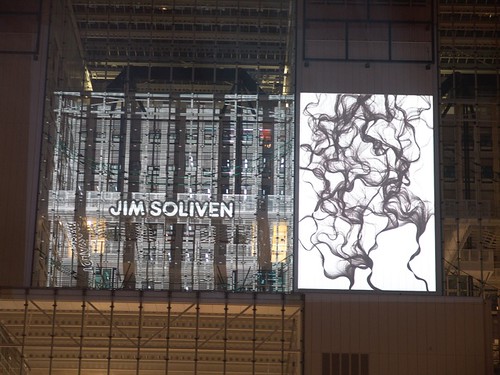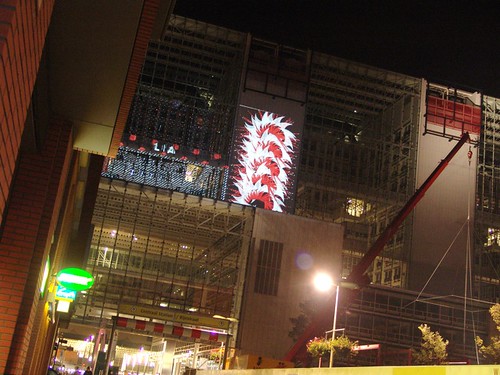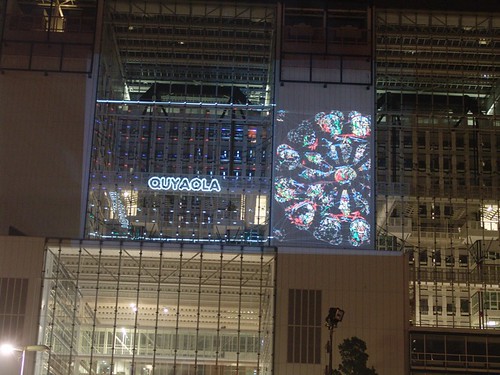shape collage-sample-heart-images-collage-key-serial-crack-licence.jpg
Image by Shekhar_Sahu
know more
www.whitehatandroid.com/2010/03/shape-collage-pro-graphic...
MAXALOT : PROCESSING LIGHT @ TodaysArt 2008
Image by todaysart
www.maxalot.com/
What if you had a special little helper who could assist your own creativity into creating the most intricate layout of various curious and beautifully detailed objects and things. Who would be the real creator? What if you had actually made this special little helper yourself to begin with? Artists working with programming do just that, they create a very powerful creator and let them do the hard work. Through computer software algorithms written in various scripting languages more and more artists now use these powerful tools to have information generate mind blowing imagery. This "processing" of information happens in a combination of order and disorder, and although most behaviours are very much so controlled by the artists, the outcome is always somewhat of a surprise. For this event, this public outdoor exhibition, Maxalot will present a selection of todays finest generative artists and have their work light up part of the VROM building next to The Hague's Central Station using another powerful tool, Light.
Maxalot
Maxalot crosses digital arts with emerging pop surrealism, aiming to reach broad audiences with individuals and studios who break boundaries in art and design. Formerly based in Barcelona, the Maxalots have returned to their motherland, Holland and now curate exhibitions in a series of unconventional venues throughout the city of Amsterdam. Since their debut in 2003, Maxalot has set course to become an influential force in the global graphic and design community and now incorporates an online boutique offering unique objets d'art, limited edition giclée prints and graphic wallscapes.
ARTISTS:
Neil Banas
Neil Banas is a digital artist and computational oceanographer living, working, and teaching in Seattle. Inspiration for his work comes sometimes from pure math and geometry but more often from dynamics in nature. This piece is based on a simulation of millions of faint particles running down invisible hillsides, spreading and converging like water in a stream network or draining off mudflats at low tide.
Dextro
Dextro.org presents abstract graphic design experiments and algorithmic animations. In cooperation with Lia, Dextro initiated turux.org, a platform for interactive animations
Eno Henze
Eno Henze likes to employ computers to do his work. Hence, his work focuses on generative processes involving both human and machine intelligence. He graduated in Fine Arts at the Städelschule Frankfurt and recently moved to Berlin with his studio. He also works as designer and art director for digital media environments. Eno has created an artwork called "Party Collider" for this show.
Pedro Mari
Pedro Mari (born 1986 in Salerno, Italy), also known as Defetto, currently lives and works in London.
He's an audiovisual artist focused on generative systems. Most of his works deal with synesthesia and visual music, through the use of abstract shapes and a deep study of colour. Pedro will show a work titled ????? ??? (panta rei - everything flows) "Everything is subject to change. The harmony of things is contained in their perennial change. This change is not random or chaotic; it is governed by precise rhythms. ????? ??? is an eternal flow, constantly evolving, never equal to himself." Pedro Mari's work can be found online at flickr.com/defetto and vimeo.com/defetto.
Quayola
Quayola is a visual artist based in London. His work simultaneously focuses on multiple forms exploring the space between video, audio, photography, installation, live performance and print. Quayola creates worlds where real substance, such as natural or architectural matter, constantly mutates into ephemeral objects, enabling the real and the artificial to coexist harmoniously. Integrating computer-generated material with recorded sources, he explores the ambiguity of realism in the digital realm.
C.E.B REAS
C.E.B. REAS lives and works in Los Angeles. He focuses on defining processes and translating them into images. He is an associate professor and chair of the department of Design | Media Arts at the University of California, Los Angeles. With Ben Fry, REAS initiated Processing.org in 2001. Processing is an open source programming language and environment for creating images, animation, and interaction.
Karsten Smidt
"From the 1st moment I used a computer some 16 years ago, aged 13, I knew what I wanted to do later in life. Being an active part of the Demo scene back in the early '90s, I've been programming and experimenting with code, graphics and audio for all that time and still only feel like at the beginning of the real journey."
StrangeThingsHappen
Early pioneers of generative Director programming, Lia and Dextro quickly became influential both inside and outside the Director community. Their mix of crisp pixels, erratic animation and blurred surfaces was unique during the early and mid-1990's, presenting a perfect visual counterpoint to a musical scene experimenting with glitch and sound defects.
Together, they produced Turux, a seminal web site which featured Director "soundtoys" and generative visual sketches. Thanks to the site's intentionally cryptic interface design and the "anonymous author`' fad popular with the Vienna artists (many of which used pseudonyms or group names), the authorship of Turux was unclear to outsiders. Often, visitors had no idea if Lia, Dextro or Turux were actual people or just project names. Nevertheless, Turux became an important reference for the nascent scene, its fame only heightened by its obscure origin. When the collaboration ended some time later, Turux remained online practically unchanged. As a document of a specific time period (1997-2001), it became a time capsule of styles and strategies. Now Lia is running her company StrangeThingsHappen.
Jim Soliven
Jim Soliven is a programmer and computational artist based in New York City. Armed with his Apple II+, he started exploring the computational world of artistic visualization at an early age. Although driven for his love of computer-based art, his artistic journey came to a halt when he decided to go to a more stable path as a programmer. He now spends a significant amount of his free time re-discovering his love of generating nature-inspired images on his computer using the tools that he learned as a programmer. His works has made it to university press books and magazines.
Marius Watz
Marius Watz is an artist concerned with generative systems for creating visual form, still, animated or realtime. His signature is a brand of visual hedonism, marked by colourful organic shapes and a maximalist attitude. Most of his works deal with drawing machines implemented in software, live visuals for music or large-scale projections of plastic visual systems. In 2005 Watz started Generator.x, a platform for generative art and design which so far has resulted in a conference, a blog, a travelling exhibition and concert tour. In 2005 Watz received an honorary mention for his project Universal Digest Machine. Watz currently lives in Berlin. His tools of choice are Java, Processing, VVVV and Flash. He continues to edit the Generator.x blog and prepare future Generator.x events, as well as teach workshops in computational design and generative art.
Mike Young
Originally born and raised in Tennessee, Michael Young currently calls Bangkok, Thailand home. Michael started his career as one of the directors for progressive firm Vir2l and its world renowned rethinking of web design from 1998-2000. In 2000 he left Vir2l to start the prestigious design firm WeWorkForThem that has worked with the likes of Coca-Cola, Pepsi, HP, Apple and Microsoft. While not working in the commercial industry of graphic design, Michael's online project Designgraphik has been at the forefront of online-interactive art since 1998. In 2001, at only age 23 he was nominated for the highly prestigious Chrysler Design Award, typically reserved for architects. Although not winning the Chrysler, Michael's innovative work online and in video have gone on to be exhibited around the world from America to Asia and Australia to Europe. Michael continues to work daily as a artist, designer, photographer, director, producer and hack programmer.
MAXALOT : PROCESSING LIGHT @ TodaysArt 2008
Image by todaysart
www.maxalot.com/
What if you had a special little helper who could assist your own creativity into creating the most intricate layout of various curious and beautifully detailed objects and things. Who would be the real creator? What if you had actually made this special little helper yourself to begin with? Artists working with programming do just that, they create a very powerful creator and let them do the hard work. Through computer software algorithms written in various scripting languages more and more artists now use these powerful tools to have information generate mind blowing imagery. This "processing" of information happens in a combination of order and disorder, and although most behaviours are very much so controlled by the artists, the outcome is always somewhat of a surprise. For this event, this public outdoor exhibition, Maxalot will present a selection of todays finest generative artists and have their work light up part of the VROM building next to The Hague's Central Station using another powerful tool, Light.
Maxalot
Maxalot crosses digital arts with emerging pop surrealism, aiming to reach broad audiences with individuals and studios who break boundaries in art and design. Formerly based in Barcelona, the Maxalots have returned to their motherland, Holland and now curate exhibitions in a series of unconventional venues throughout the city of Amsterdam. Since their debut in 2003, Maxalot has set course to become an influential force in the global graphic and design community and now incorporates an online boutique offering unique objets d'art, limited edition giclée prints and graphic wallscapes.
ARTISTS:
Neil Banas
Neil Banas is a digital artist and computational oceanographer living, working, and teaching in Seattle. Inspiration for his work comes sometimes from pure math and geometry but more often from dynamics in nature. This piece is based on a simulation of millions of faint particles running down invisible hillsides, spreading and converging like water in a stream network or draining off mudflats at low tide.
Dextro
Dextro.org presents abstract graphic design experiments and algorithmic animations. In cooperation with Lia, Dextro initiated turux.org, a platform for interactive animations
Eno Henze
Eno Henze likes to employ computers to do his work. Hence, his work focuses on generative processes involving both human and machine intelligence. He graduated in Fine Arts at the Städelschule Frankfurt and recently moved to Berlin with his studio. He also works as designer and art director for digital media environments. Eno has created an artwork called "Party Collider" for this show.
Pedro Mari
Pedro Mari (born 1986 in Salerno, Italy), also known as Defetto, currently lives and works in London.
He's an audiovisual artist focused on generative systems. Most of his works deal with synesthesia and visual music, through the use of abstract shapes and a deep study of colour. Pedro will show a work titled ????? ??? (panta rei - everything flows) "Everything is subject to change. The harmony of things is contained in their perennial change. This change is not random or chaotic; it is governed by precise rhythms. ????? ??? is an eternal flow, constantly evolving, never equal to himself." Pedro Mari's work can be found online at flickr.com/defetto and vimeo.com/defetto.
Quayola
Quayola is a visual artist based in London. His work simultaneously focuses on multiple forms exploring the space between video, audio, photography, installation, live performance and print. Quayola creates worlds where real substance, such as natural or architectural matter, constantly mutates into ephemeral objects, enabling the real and the artificial to coexist harmoniously. Integrating computer-generated material with recorded sources, he explores the ambiguity of realism in the digital realm.
C.E.B REAS
C.E.B. REAS lives and works in Los Angeles. He focuses on defining processes and translating them into images. He is an associate professor and chair of the department of Design | Media Arts at the University of California, Los Angeles. With Ben Fry, REAS initiated Processing.org in 2001. Processing is an open source programming language and environment for creating images, animation, and interaction.
Karsten Smidt
"From the 1st moment I used a computer some 16 years ago, aged 13, I knew what I wanted to do later in life. Being an active part of the Demo scene back in the early '90s, I've been programming and experimenting with code, graphics and audio for all that time and still only feel like at the beginning of the real journey."
StrangeThingsHappen
Early pioneers of generative Director programming, Lia and Dextro quickly became influential both inside and outside the Director community. Their mix of crisp pixels, erratic animation and blurred surfaces was unique during the early and mid-1990's, presenting a perfect visual counterpoint to a musical scene experimenting with glitch and sound defects.
Together, they produced Turux, a seminal web site which featured Director "soundtoys" and generative visual sketches. Thanks to the site's intentionally cryptic interface design and the "anonymous author`' fad popular with the Vienna artists (many of which used pseudonyms or group names), the authorship of Turux was unclear to outsiders. Often, visitors had no idea if Lia, Dextro or Turux were actual people or just project names. Nevertheless, Turux became an important reference for the nascent scene, its fame only heightened by its obscure origin. When the collaboration ended some time later, Turux remained online practically unchanged. As a document of a specific time period (1997-2001), it became a time capsule of styles and strategies. Now Lia is running her company StrangeThingsHappen.
Jim Soliven
Jim Soliven is a programmer and computational artist based in New York City. Armed with his Apple II+, he started exploring the computational world of artistic visualization at an early age. Although driven for his love of computer-based art, his artistic journey came to a halt when he decided to go to a more stable path as a programmer. He now spends a significant amount of his free time re-discovering his love of generating nature-inspired images on his computer using the tools that he learned as a programmer. His works has made it to university press books and magazines.
Marius Watz
Marius Watz is an artist concerned with generative systems for creating visual form, still, animated or realtime. His signature is a brand of visual hedonism, marked by colourful organic shapes and a maximalist attitude. Most of his works deal with drawing machines implemented in software, live visuals for music or large-scale projections of plastic visual systems. In 2005 Watz started Generator.x, a platform for generative art and design which so far has resulted in a conference, a blog, a travelling exhibition and concert tour. In 2005 Watz received an honorary mention for his project Universal Digest Machine. Watz currently lives in Berlin. His tools of choice are Java, Processing, VVVV and Flash. He continues to edit the Generator.x blog and prepare future Generator.x events, as well as teach workshops in computational design and generative art.
Mike Young
Originally born and raised in Tennessee, Michael Young currently calls Bangkok, Thailand home. Michael started his career as one of the directors for progressive firm Vir2l and its world renowned rethinking of web design from 1998-2000. In 2000 he left Vir2l to start the prestigious design firm WeWorkForThem that has worked with the likes of Coca-Cola, Pepsi, HP, Apple and Microsoft. While not working in the commercial industry of graphic design, Michael's online project Designgraphik has been at the forefront of online-interactive art since 1998. In 2001, at only age 23 he was nominated for the highly prestigious Chrysler Design Award, typically reserved for architects. Although not winning the Chrysler, Michael's innovative work online and in video have gone on to be exhibited around the world from America to Asia and Australia to Europe. Michael continues to work daily as a artist, designer, photographer, director, producer and hack programmer.
MAXALOT : PROCESSING LIGHT @ TodaysArt 2008
Image by todaysart
www.maxalot.com/
What if you had a special little helper who could assist your own creativity into creating the most intricate layout of various curious and beautifully detailed objects and things. Who would be the real creator? What if you had actually made this special little helper yourself to begin with? Artists working with programming do just that, they create a very powerful creator and let them do the hard work. Through computer software algorithms written in various scripting languages more and more artists now use these powerful tools to have information generate mind blowing imagery. This "processing" of information happens in a combination of order and disorder, and although most behaviours are very much so controlled by the artists, the outcome is always somewhat of a surprise. For this event, this public outdoor exhibition, Maxalot will present a selection of todays finest generative artists and have their work light up part of the VROM building next to The Hague's Central Station using another powerful tool, Light.
Maxalot
Maxalot crosses digital arts with emerging pop surrealism, aiming to reach broad audiences with individuals and studios who break boundaries in art and design. Formerly based in Barcelona, the Maxalots have returned to their motherland, Holland and now curate exhibitions in a series of unconventional venues throughout the city of Amsterdam. Since their debut in 2003, Maxalot has set course to become an influential force in the global graphic and design community and now incorporates an online boutique offering unique objets d'art, limited edition giclée prints and graphic wallscapes.
ARTISTS:
Neil Banas
Neil Banas is a digital artist and computational oceanographer living, working, and teaching in Seattle. Inspiration for his work comes sometimes from pure math and geometry but more often from dynamics in nature. This piece is based on a simulation of millions of faint particles running down invisible hillsides, spreading and converging like water in a stream network or draining off mudflats at low tide.
Dextro
Dextro.org presents abstract graphic design experiments and algorithmic animations. In cooperation with Lia, Dextro initiated turux.org, a platform for interactive animations
Eno Henze
Eno Henze likes to employ computers to do his work. Hence, his work focuses on generative processes involving both human and machine intelligence. He graduated in Fine Arts at the Städelschule Frankfurt and recently moved to Berlin with his studio. He also works as designer and art director for digital media environments. Eno has created an artwork called "Party Collider" for this show.
Pedro Mari
Pedro Mari (born 1986 in Salerno, Italy), also known as Defetto, currently lives and works in London.
He's an audiovisual artist focused on generative systems. Most of his works deal with synesthesia and visual music, through the use of abstract shapes and a deep study of colour. Pedro will show a work titled ????? ??? (panta rei - everything flows) "Everything is subject to change. The harmony of things is contained in their perennial change. This change is not random or chaotic; it is governed by precise rhythms. ????? ??? is an eternal flow, constantly evolving, never equal to himself." Pedro Mari's work can be found online at flickr.com/defetto and vimeo.com/defetto.
Quayola
Quayola is a visual artist based in London. His work simultaneously focuses on multiple forms exploring the space between video, audio, photography, installation, live performance and print. Quayola creates worlds where real substance, such as natural or architectural matter, constantly mutates into ephemeral objects, enabling the real and the artificial to coexist harmoniously. Integrating computer-generated material with recorded sources, he explores the ambiguity of realism in the digital realm.
C.E.B REAS
C.E.B. REAS lives and works in Los Angeles. He focuses on defining processes and translating them into images. He is an associate professor and chair of the department of Design | Media Arts at the University of California, Los Angeles. With Ben Fry, REAS initiated Processing.org in 2001. Processing is an open source programming language and environment for creating images, animation, and interaction.
Karsten Smidt
"From the 1st moment I used a computer some 16 years ago, aged 13, I knew what I wanted to do later in life. Being an active part of the Demo scene back in the early '90s, I've been programming and experimenting with code, graphics and audio for all that time and still only feel like at the beginning of the real journey."
StrangeThingsHappen
Early pioneers of generative Director programming, Lia and Dextro quickly became influential both inside and outside the Director community. Their mix of crisp pixels, erratic animation and blurred surfaces was unique during the early and mid-1990's, presenting a perfect visual counterpoint to a musical scene experimenting with glitch and sound defects.
Together, they produced Turux, a seminal web site which featured Director "soundtoys" and generative visual sketches. Thanks to the site's intentionally cryptic interface design and the "anonymous author`' fad popular with the Vienna artists (many of which used pseudonyms or group names), the authorship of Turux was unclear to outsiders. Often, visitors had no idea if Lia, Dextro or Turux were actual people or just project names. Nevertheless, Turux became an important reference for the nascent scene, its fame only heightened by its obscure origin. When the collaboration ended some time later, Turux remained online practically unchanged. As a document of a specific time period (1997-2001), it became a time capsule of styles and strategies. Now Lia is running her company StrangeThingsHappen.
Jim Soliven
Jim Soliven is a programmer and computational artist based in New York City. Armed with his Apple II+, he started exploring the computational world of artistic visualization at an early age. Although driven for his love of computer-based art, his artistic journey came to a halt when he decided to go to a more stable path as a programmer. He now spends a significant amount of his free time re-discovering his love of generating nature-inspired images on his computer using the tools that he learned as a programmer. His works has made it to university press books and magazines.
Marius Watz
Marius Watz is an artist concerned with generative systems for creating visual form, still, animated or realtime. His signature is a brand of visual hedonism, marked by colourful organic shapes and a maximalist attitude. Most of his works deal with drawing machines implemented in software, live visuals for music or large-scale projections of plastic visual systems. In 2005 Watz started Generator.x, a platform for generative art and design which so far has resulted in a conference, a blog, a travelling exhibition and concert tour. In 2005 Watz received an honorary mention for his project Universal Digest Machine. Watz currently lives in Berlin. His tools of choice are Java, Processing, VVVV and Flash. He continues to edit the Generator.x blog and prepare future Generator.x events, as well as teach workshops in computational design and generative art.
Mike Young
Originally born and raised in Tennessee, Michael Young currently calls Bangkok, Thailand home. Michael started his career as one of the directors for progressive firm Vir2l and its world renowned rethinking of web design from 1998-2000. In 2000 he left Vir2l to start the prestigious design firm WeWorkForThem that has worked with the likes of Coca-Cola, Pepsi, HP, Apple and Microsoft. While not working in the commercial industry of graphic design, Michael's online project Designgraphik has been at the forefront of online-interactive art since 1998. In 2001, at only age 23 he was nominated for the highly prestigious Chrysler Design Award, typically reserved for architects. Although not winning the Chrysler, Michael's innovative work online and in video have gone on to be exhibited around the world from America to Asia and Australia to Europe. Michael continues to work daily as a artist, designer, photographer, director, producer and hack programmer.
Graphic Design Photo: Cool Learn Graphic Design Online Images >>>>> Download Now
ReplyDelete>>>>> Download Full
Graphic Design Photo: Cool Learn Graphic Design Online Images >>>>> Download LINK
>>>>> Download Now
Graphic Design Photo: Cool Learn Graphic Design Online Images >>>>> Download Full
>>>>> Download LINK yN